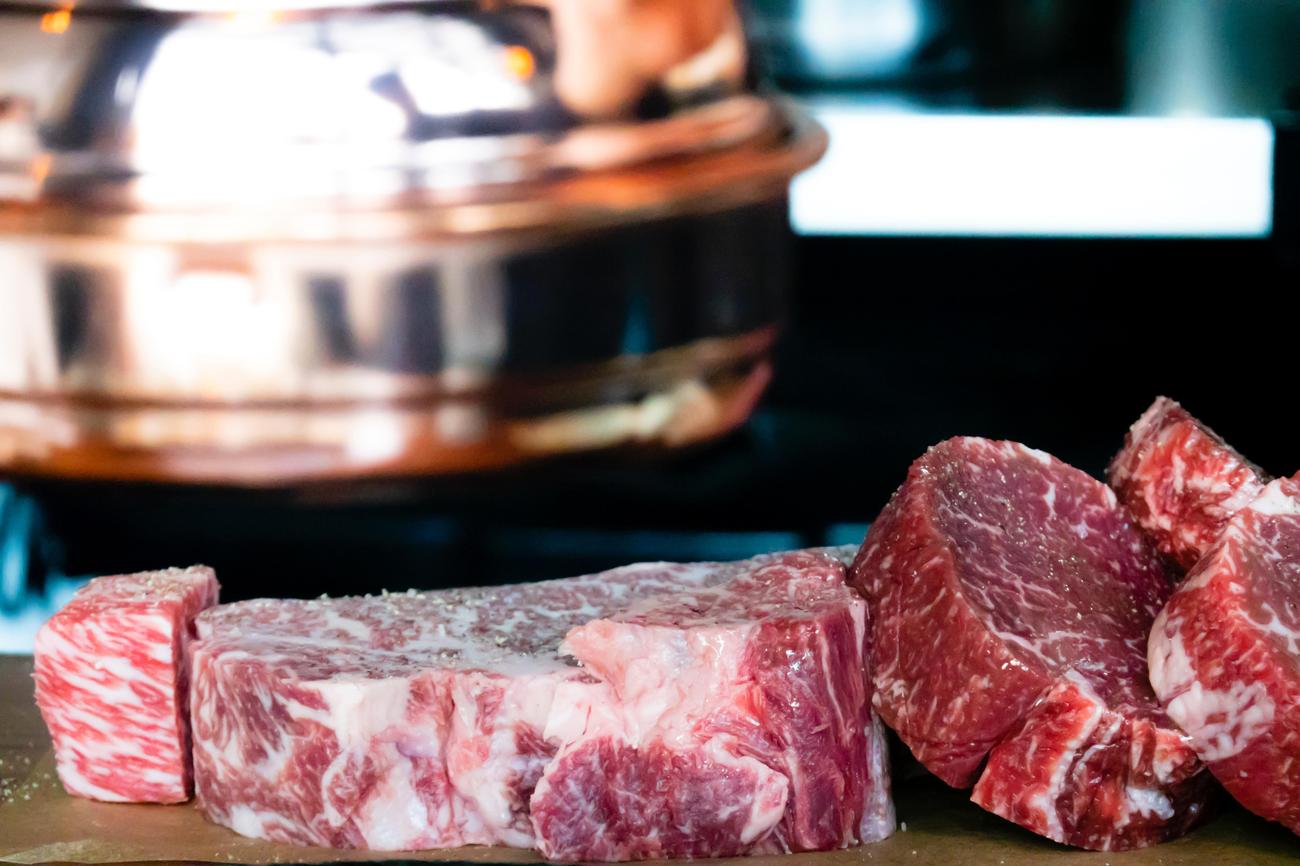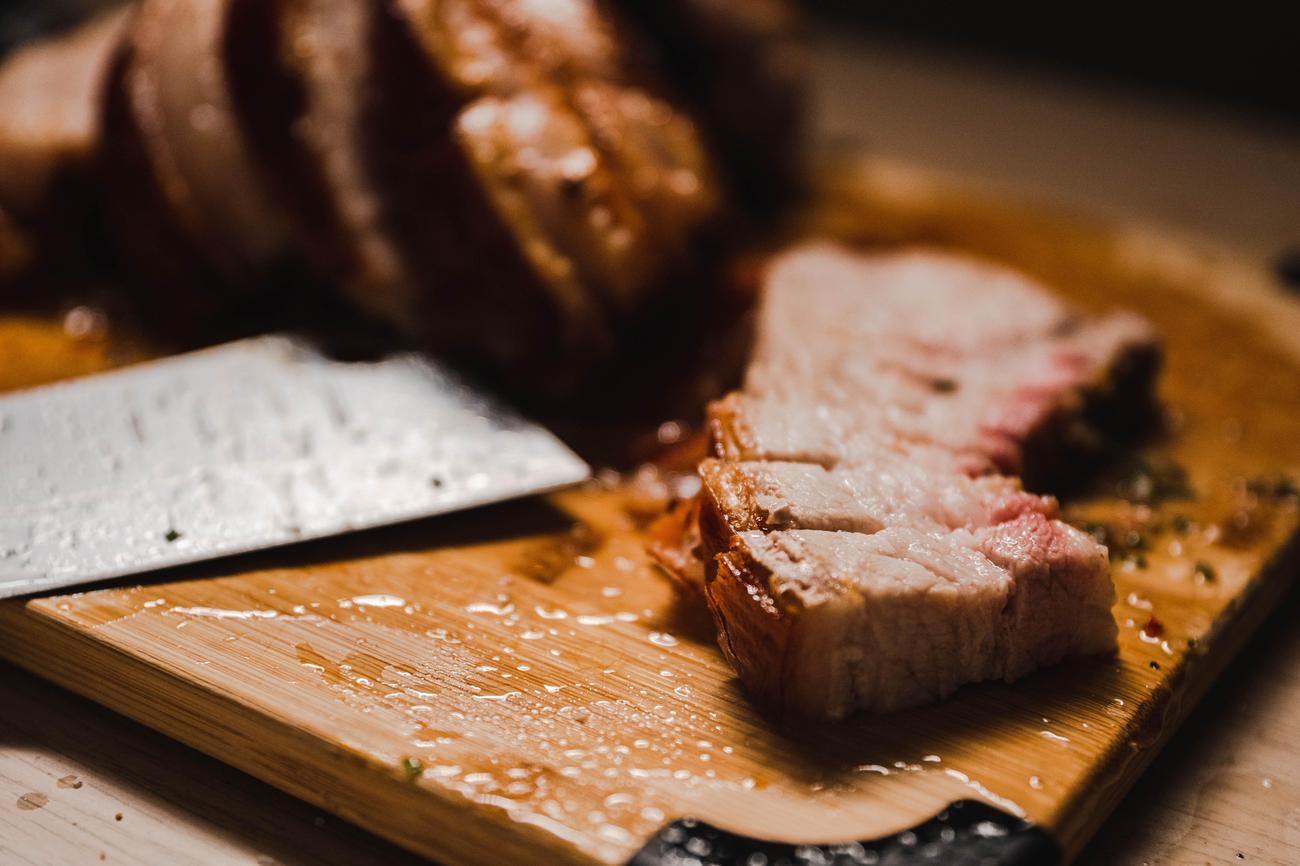Are you ready to dive into the sizzling world of steak and uncover three fascinating facts about this beloved dish? As a seasoned food aficionado and culinary expert, I have embarked on a culinary journey that revolves around the tantalizing realm of meat. With years of experience in the industry and a deep understanding of various cuts, cooking techniques, and flavor profiles, I am here to guide you through the intriguing world of steaks. So sit back, grab your apron, and get ready to explore the delicious details of steak cuts that will leave your taste buds craving for more. Let’s dive in and discover the three captivating facts that you need to know about steak!

Facts About Steak
Steak, oh how it tantalizes our taste buds and satisfies our carnivorous cravings! But did you know that this beloved slice of meat holds a treasure trove of fascinating facts? From its tender cuts to its flavorful origins, let’s dive deep into the sizzling world of steak and uncover some captivating details.
1. Steak: More than Meets the Eye
When you hear the word “steak,” you might picture a juicy slab of beef on your plate. However, steak is not just limited to beef; it can also be made from other types of meat, such as pork, lamb, or even fish! So, the next time you’re at a restaurant or browsing the meat section at your local grocery store, keep in mind that the possibilities for a delectable steak go beyond beef alone.
2. The Art of Aging
One of the secrets to achieving an incredibly tender steak lies in the aging process. Did you know that certain cuts of beef are aged for weeks or even months to enhance their flavor and tenderness? During this process, enzymes naturally present in the meat break down connective tissues, resulting in a more succulent and melt-in-your-mouth experience. So, the next time you sink your teeth into a perfectly aged steak, savor the craftsmanship that went into its preparation.
3. Doneness: A Matter of Preference
Whether you prefer a rare, medium-rare, or well-done steak, achieving the perfect doneness is a delicate art. It’s all about finding that sweet spot where the meat is cooked to your desired level without compromising its juiciness. From the vibrant pink center of a medium-rare steak to the charred crust of a well-done cut, there’s a level of doneness that caters to everyone’s taste buds. So, experiment with different cooking times and temperatures to discover your steak nirvana.
“Remember, the doneness of your steak is a personal preference, so grill it to perfection, just the way you like it.”
4. Searing Steak: The Maillard Reaction
Ever wondered why a seared steak boasts a beautifully browned and caramelized crust? It’s all thanks to a chemical reaction called the Maillard reaction. When heat is applied to the proteins and sugars on the surface of the meat, they undergo a complex transformation, resulting in a delightful symphony of flavors and aromas. So, the next time you’re searing a juicy steak, embrace the sizzle and relish the magic of the Maillard reaction.
5. Cuts Galore: The World of Steak Varieties
Steak comes in a wide array of cuts, each offering its unique texture, flavor, and tenderness. From the buttery tenderness of a filet mignon to the rich marbling of a ribeye, there’s a steak for every palate. So, explore the vast world of steak cuts, talk to your local butcher, and discover your new favorite slice of meat. Whether you fancy a tenderloin, strip steak, or T-bone, each cut promises a unique dining experience.
6. A Symphony of Seasonings
While a perfectly cooked steak can stand on its own, seasonings have the power to take it to new heights of flavor. From the classic combination of salt and pepper to tantalizing marinades and rubs, the possibilities are endless. So, don’t shy away from experimenting with different seasonings to find your preferred flavor profile. Whether you crave a burst of garlic, a hint of smokiness, or a touch of spice, let your taste buds guide you on a flavorful journey.
7. Pairing Pleasures: Steak and Wine
Ah, the heavenly bliss of a well-paired steak and wine! When it comes to complementing the flavors of a juicy steak, the right wine can elevate the dining experience. Whether you prefer a full-bodied Cabernet Sauvignon, a velvety Malbec, or a robust Syrah, the rich tannins and complex flavors of red wines harmonize beautifully with the succulence of steak. So, next time you’re indulging in a steak feast, raise your glass and savor the perfect union of flavors.
8. Sustainable Sourcing: A Growing Trend
In recent years, the importance of sustainable food choices has taken center stage. This shift in consciousness has also impacted the steak industry. Now more than ever, people are seeking out steaks sourced from ethically raised animals, free from hormones and antibiotics. Additionally, grass-fed beef has gained popularity for its lower fat content and favorable fatty acid profile. So, when you choose your steak, consider supporting sustainable practices that prioritize animal welfare and environmental stewardship.
“Remember, you hold the power to make sustainable choices. By opting for ethically sourced steaks, you’re not only savoring the flavors on your plate but also promoting a more sustainable food system.”
As we bid adieu to our journey through the sizzling world of steak, we leave you with one final thought. Steak, beyond its culinary allure, embodies the passion and skill of those who prepare it, who dedicate themselves to delivering the perfect bite with every sizzle and sear. So, go forth, armed with these fascinating facts, and let the world of steak continue to enthrall and delight your taste buds. Stay hungry, steak enthusiasts, and keep exploring the mouthwatering wonders that await.
Facts about steak can be truly fascinating, with each variation offering its own unique characteristics. If you’re curious about steak frites, look no further than our enlightening article on the subject. With a crispy and golden exterior, paired with tender cuts of steak, this classic French dish is a must-try. Discover more about the history, preparation techniques, and other interesting tidbits by clicking here: facts about steak frites.
For those who have a fondness for tacos, we’ve got just the right article for you. Explore the captivating world of steak tacos, where succulent strips of steak marry perfectly with tortillas and an array of delectable toppings. Satisfy your cravings and delve into the fascinating origins and variations of this beloved Mexican delight by clicking here: facts about steak tacos.
If you want to learn more about Longhorn Steakhouse, we have all the intriguing details you’ve been craving. Discover the rich heritage and mouthwatering steak options that this popular restaurant chain has to offer. From perfectly marbled ribeyes to tender filet mignons, explore their menu and tradition by clicking here: facts about Longhorn Steakhouse.
Have you ever heard of steak tartare? This unique culinary delight is worth exploring, as it showcases raw beef that is expertly seasoned and combined with a variety of flavorful ingredients. Unleash your taste buds and venture into the realm of steak tartare by clicking here: facts about steak tartare.
Steak lovers, brace yourselves for a fascinating ride through fun facts about steak. Did you know that the most expensive steak in the world costs a mind-boggling $3,200? From exotic cuts to grilling techniques, dive deep into the world of steak enthusiasts by clicking here: fun facts about steak.
For those who are conscious about their nutrition, we have the ultimate guide to the nutrition facts about steak. Learn about the protein-packed benefits, essential vitamins and minerals, and other valuable nutritional insights about this beloved meat. Fuel your body with knowledge by clicking here: nutrition facts about steak.
So, whether you are a fan of steak frites, steak tacos, Longhorn Steakhouse, steak tartare, or simply want to explore some fun and nutrition facts about steak, our collection of articles has got you covered. Let your curiosity take you on a tantalizing journey through the world of steak!
3 Facts About Steak
As a seasoned food aficionado with years of experience in the culinary industry, I can’t help but dive into the sizzling world of steak and uncover some fascinating facts. So grab your steak knife and get ready to sink your teeth into these three intriguing insights about everyone’s favorite savory delight.
1. The History of Steak
Steak has a rich and storied history that stretches back centuries. While the word “steak” is believed to have originated from an old Scandinavian term meaning “roast meat,” did you know that the original term for a steak was actually “stelk”? Yes, that’s right! “Stelk” meant “meat on a stick,” which hints at the early method of cooking steak. In ancient times, people would impale the meat on wooden skewers and roast it over an open fire, savoring the deliciousness that would later evolve into the perfectly cooked steaks we enjoy today. [quote] From humble beginnings on a stick to the succulent steaks we savor now, steak has truly come a long way.
2. The Art of Steak Pairings
When it comes to elevating the flavor experience of steak, pairing it with the right beverage can make all the difference. While many may opt for a glass of red wine, did you know that steak also pairs exceptionally well with beer? The malty flavors and carbonation of certain beers can complement the richness of the steak, creating a delightful harmony of tastes. So, next time you’re grilling up a juicy steak, consider reaching for a frosty brew to enhance the dining experience. [quote] Whether your preference lies in a velvety red wine or a crisp beer, a well-chosen pairing can take your steak enjoyment to new heights.
3. Steak: A Symbol of Passion and Creativity
Beyond its deliciousness, steak has also made waves in the world of fashion and culture. In 2010, the iconic musician Lady Gaga caused a sensation when she donned a dress made entirely of raw steak to an event. While the dress certainly turned heads and sparked conversations, it also highlighted the cultural significance of steak as a symbol of passion and creativity. Steak has become a staple ingredient in many menus and dishes worldwide, allowing chefs and food enthusiasts alike to get creative and showcase their culinary prowess. So, the next time you savor a beautifully cooked steak, remember that it not only satisfies your taste buds but also carries a legacy of culinary artistry and innovation. [quote] Steak has transcended its role as a simple dish and become a canvas for culinary inspiration and self-expression.
In conclusion, these three captivating facts about steak shed light on its historical roots, the art of pairing, and its cultural significance. From its humble beginnings as “stelk” to its modern-day presence as a culinary masterpiece, steak continues to enthrall and delight food lovers around the globe. So, the next time you savor a mouthwatering steak, savor not only its flavor but also the intriguing stories that accompany this beloved protein. [quote] Let the sizzling world of steak ignite your curiosity and leave you hungry for more knowledge about this timeless dish.
Know Your Cuts
When it comes to steak, understanding the different cuts is essential for any meat lover. Each cut comes from a specific part of the cow’s back and offers its own unique tenderness, flavor, and price point. So, let’s dive into the mesmerizing world of steak cuts and uncover fascinating facts that will leave you craving for more knowledge about these mouthwatering delights.
The Rib Section: Exploring Flavorful Indulgence
The rib section of the cow is home to some beloved steak cuts. Starting with the rib roast, this cut is often slow-roasted to perfection, resulting in succulent, tender meat that captures the full-bodied flavors of the beef. Moving on to the rib-eye steak, this cut is renowned for its marbling, which enhances both the flavor and juiciness. Lastly, we have the back ribs, which offer a delightful combination of meat and bone, perfect for those who enjoy a more primal, hands-on experience.
The rib section holds a treasure trove of indulgence, offering cuts like the rib roast, rib-eye steak, and back ribs. These cuts deliver sensational flavors and textures that will make your taste buds dance with joy.
The Sirloin: Lean Marvels Packed with Flavor
The sirloin steak takes us to the top of the cow’s back and offers a lean and flavorful experience. This cut boasts a fine balance between tenderness and meatiness, making it an all-time favorite. With its bold flavor profile and versatility, the sirloin steak holds its own when it comes to grilling, searing, or broiling. Whether you prefer it as a steakhouse classic or sliced up in a delicious stir-fry, the sirloin won’t disappoint.
Lean yet bursting with flavor, the sirloin steak is a true marvel that showcases the cow’s excellence in every bite.
The Loin: Bursting with Tender Awesomeness
For those seeking ultimate tenderness, the loin section has got you covered. Say hello to the strip steak and tenderloin steak, two unforgettable cuts that will make your dining experience truly extraordinary. The strip steak, also known as New York strip or Kansas City strip, impresses with its juicy and tender texture, making it a popular choice among steak enthusiasts. Meanwhile, the tenderloin steak, famously recognized as the filet mignon, takes tenderness to a whole new level. It’s the crème de la crème of steaks, albeit at a higher price point.
The loin offers a haven of tenderness, showcasing cuts like the strip steak and the tenderloin steak that will leave you speechless with their melt-in-your-mouth perfection.
The T-Bone: Two Steaks in One Stunning Package
Picture this: a steak that combines the best of two worlds. That’s precisely what the T-bone steak offers. This spectacular cut consists of the strip and the tenderloin, separated by a T-shaped bone. As you savor its rich and distinct flavors, you’ll enjoy the best of both tenderloin indulgence and the boldness of the strip.
The T-bone steak is a tantalizing package that brings together the divine tenderness of the tenderloin and the robust flavors of the strip, creating a truly unforgettable culinary experience.
The Round: Lean and Versatile
The round section offers a lean and versatile cut of steak. It’s often used for dishes like London broil, where marinating and slicing against the grain can result in a flavorful meal. While it may not possess the tenderness of other cuts, the round steak shines when cooked with precision and paired with complementary flavors.
Though lean and not as tender as other cuts, the round steak makes up for it with its versatility and the potential to create delectable culinary masterpieces.
Delving into the Wealth of Steak Knowledge
Now that you’ve delved into the fascinating world of steak cuts, it’s clear that each one carries its own unique qualities. From the succulent rib section to the tender and flavorful loins, and the tempting T-bone, there’s a world of flavors waiting to be explored. And while we’ve only scratched the surface, these delicious cuts will undoubtedly ignite your curiosity and make you appreciate steak even more.
With a myriad of steak cuts to choose from, your culinary journeys are bound to take you on a thrilling adventure, uncovering the diverse flavors and textures that this beloved dish has to offer.
For more information on steak cuts or to deepen your steak knowledge, you can explore resources such as [thespruceeats.com], [steaksociety.com], [adamsgrilleprincefrederick.com], and [thebigprawn.com]. These sources provide a wealth of information to satisfy your appetite for steak-related insights.
So, next time you savor a juicy steak, take a moment to appreciate the expertise and craftsmanship involved in bringing that perfect cut to your plate. Let your taste buds be your guide as you embark on a journey through the sizzling world of steak.
False Myths About Steak That Everyone Believes
[youtube v=”PSeTRJw_Fss”]
The Pinkish Red Liquid: It’s Not Blood, It’s Myoglobin
One common misconception about steak is the pinkish red liquid that oozes out when it’s cooked. Contrary to popular belief, this liquid is not blood. It’s called myoglobin, a protein found in animal tissue that delivers oxygen to the muscles. While it may resemble blood, rest assured that myoglobin is safe to consume and has nothing to do with blood. As a steak is cooked, the myoglobin darkens, which is why a rare steak appears bloodier than a well-done one. So, embrace the juiciness of a well-cooked steak—it’s part of what makes it enjoyable.
“The liquid that comes out of a cooked steak is actually called myoglobin, and it’s a protein in animal tissue. Luckily, it’s safe to eat and doesn’t have anything to do with blood.”
The Safety of Rare Steak
It’s often believed that eating rare or raw steak is dangerous, but it’s not as risky as consuming other types of raw meat. While proper cooking temperatures are crucial for ensuring safety, the majority of bacteria that can cause illness from raw meat is usually found on the surface. Ground beef, for instance, can harbor bacteria throughout the product, which is why it’s recommended to cook it thoroughly. On the other hand, a steak has most of the bacteria on its surface, making it safer to eat rare. However, it’s still important to follow food safety guidelines and cook steak to the appropriate temperature.
“While consuming rare steak may pose some health risks, it’s not as dangerous as other types of raw meat. Most of the bacteria in a steak will remain on the surface, making it safer to eat rare.”
The Role of Salt in Seasoning
There’s a common myth that salting steak before cooking it is bad. However, there’s no good reason to avoid salting your steak. In fact, salting it before cooking brings out more flavor and is important for a process called dry brining. To enhance the flavor, it’s best to salt your steak about 40 minutes to 2 hours before cooking it. If you forget to plan ahead, you can still sprinkle some salt on the steak right before cooking it. Just be careful not to salt it too close to cooking time, as it may draw out moisture without enough time to dry out.
“Not only does salt bring out more flavor from the meat, but it also plays a crucial role in the dry brining process. So, don’t hesitate to salt your steak before cooking—it’s perfectly fine to do so.”
The Flip Myth
Contrary to popular belief, you can flip your steak multiple times without any negative consequences. Flipping a steak several times can actually help prevent it from drying out too much. It also reduces the risk of one side being overdone compared to the other. While some may prefer the visually appealing cross-hatch pattern that comes from flipping the steak once, it’s important to note that it may not necessarily result in the best flavor. Even renowned chefs suggest that evenly cooked steak often tastes better than those with perfect grill marks.
“Flipping a steak multiple times can prevent it from drying out and promote even cooking. While the perfect grill marks may look great, evenly cooked steak often tastes better.”
Stabbing the Steak: Does It Truly Ruin It?
Stabbing your steak with a fork before cooking or cutting it open to check its doneness does not ruin the meat. While you may lose some juices in the process, it won’t significantly affect the taste or tenderness. In fact, using a fork to flip your steak is perfectly acceptable. Cutting the steak open to check the color of the inside can give you an indication of its doneness, although using a meat thermometer is the most accurate method.
“Sticking a fork in your steak or cutting it open to check doneness doesn’t ruin it. While it may result in some juice loss, it won’t affect the taste or tenderness of the steak.”
Exploring Different Cuts of Steak
While filet may be considered the holy grail of steaks due to its tenderness, there’s a whole world of variety and flavors to explore beyond it. Different cuts like ribeye or sirloin offer their own unique textures, flavors, and richness due to varying levels of fat marbling. By trying different cuts, you can not only experience a range of flavors but also save some money, as filet tends to be the most expensive option.
“By branching out and trying different cuts of steak, you can experience a wider variety of flavors and potentially save some money. While filet is known for its tenderness, other cuts like ribeye or sirloin offer their own unique qualities.”
The Role of Fat in Searing
When searing a steak, it’s common to use oil or butter. However, for those seeking extra flavor, using rendered beef fat, known as beef tallow, can give the steak a delicious kick. Adding a small amount of beef fat to the pan can enhance the overall flavor without overpowering it. Just be cautious not to use too much fat, as it may lead to boiling rather than searing the steak.
“For those looking to add extra flavor to their seared steak, using rendered beef fat can be a delicious option. Just be sure to use it in moderation to avoid boiling the steak.”
The Searing Process
Contrary to the popular belief that a steak should be seared immediately to lock in the juices, a different method can result in a better and more flavorful crust. Gentle heating the steak at first and then searing it allows the cooking process to dry out the steak to some extent, resulting in a more even and flavorful cook. This method gives the steak ample time to develop a beautiful dark brown crust, providing a more appealing presentation without sacrificing flavor.
“Heating a steak gently before searing it can result in a more delicious crust. This method allows the steak to dry out slightly and ensures more even cooking, leading to a better overall flavor.”
Sauce or No Sauce?
Traditionally, sauces were often used to accompany steak, but nowadays, it is generally accepted that a good steak should be enjoyed without drowning it in sauce. While heavy sauces can mask the true flavor of the meat, lighter alternatives like chimichurri can complement and enhance the taste of a high-quality steak. Chimichurri, originating from Uruguay and Argentina, highlights the strengths of a steak rather than covering them up.
“While heavy steak sauces can mask the true flavor of the meat, lighter alternatives like chimichurri can enhance and complement it, emphasizing the taste of a high-quality steak.”
In conclusion, debunking these common myths about steak helps us better understand and appreciate the art of cooking the perfect steak. From understanding the protein that creates the pinkish red liquid to exploring different cuts and seasoning techniques, there’s a world of flavors and techniques waiting to be discovered. So, next time you enjoy a steak, remember to embrace its unique qualities and savor the taste.
FAQ
Question 1: What are the different cuts of steak and how do they vary in terms of tenderness, flavor, and price?
Answer 1: Steak cuts come from different parts of the cow’s back and vary in tenderness, flavor, and price. Some popular cuts include rib-eye, sirloin, strip, tenderloin, T-bone, and round. The rib section contains cuts such as rib roast, rib-eye steak, and back ribs. The sirloin steak is lean and flavorful, while the strip steak is juicy and tender. The tenderloin steak is very tender and expensive, and the T-bone steak combines the strip and tenderloin with a T-shaped bone. The round steak is lean and tough, often used for London broil.
Question 2: What are the differences between grass-fed and grain-fed beef for steak?
Answer 2: Grass-fed beef is lower in total fat and has a more favorable fatty acid profile than grain-fed beef. Grass-fed beef tends to have a slightly more distinct flavor, while grain-fed beef can be more tender due to higher fat percentages. Both types of beef can be used for steak, and the choice depends on personal preference.
Question 3: How did the word “steak” originate and what is its historical significance?
Answer 3: The word “steak” originates from the mid-15th century Scandinavian word “steik” or “stickna'” in Middle English dialect, along with the Old Norse word “steikja.” Steak quickly conquered Europe and America, and the development of livestock breeding with a focus on meat breed calves initiated the development of Stanovoy culture. “Steak” has a rich historical significance, deeply rooted in the culinary traditions of various cultures.
Question 4: What are some popular ways to cook steak?
Answer 4: Steak can be cooked in various ways, including grilling, pan-frying, and broiling. It can also be diced, cooked in sauce, or minced and formed into patties. Grilling is a recommended method for achieving the best results and taste. Different cooking techniques can enhance the flavors and textures of steak, providing a versatile culinary experience.
Question 5: Where can I find more information about cuts of steak and recipes?
Answer 5: To explore more about steak cuts and recipes, you can visit websites such as thespruceeats.com, steaksociety.com, adamsgrilleprincefrederick.com, and thebigprawn.com. These resources offer in-depth information, cooking tips, and a wide range of recipes to further your steak knowledge and culinary skills.
- Unlocking Francis Alexander Shields’ Finance Empire: A Comprehensive Biography - July 12, 2025
- Unveiling Francis Alexander Shields: A Business Legacy - July 12, 2025
- Francis Alexander Shields’ Business Career: A Comprehensive Overview - July 12, 2025















